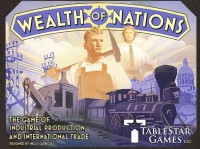
Wealth of Nations
3-6
13+
120
WELCOME TO WEALTH OF NATIONS!
Transform your nation from its humble beginnings into an economic superpower. Aggressively trade with neighboring nations and astutely manage your assets to grow mighty and cover the world with your flags. Will you drive one Industry into a massive production bloc, or diversify your infrastructure for maximum economic flexibility? How will you build your Nation?
Claim territory, build industries, and master trade as you guide your Nation to prosperity!
User Reviews (1)
Add a Review for "Wealth of Nations"
You must be logged in to add a review.

In Wealth of Nations, you are nations vying for the most economic power.
Wealth of Nations is an economic game. You are building Industry tiles to produce goods to sell for the highest price possible. The player with the most victory points at the end of the game is the winner.
The Basics:
The game takes place over several rounds that are broken down into 3 phases. In phase 1 and 2 each player, in turn will take an action until all players have passed. In phase 3 each player will produce. This will continue until a game end condition is met.
Trade Phase:
1) Buy a Commodity from the Market – You purchase a Commodity from the Market at the current price and remove the cube from the market (Thus increasing the price of the commodity)
2) Sell a Commodity to the market – You sell a Commodity to the Market at the current price and place the cube onto the market (Thus decreasing the price of the commodity)
3) Barter – You trade with other players
Promissory Notes: You can take out a loan at any time during the Trade phase (take 1 or more Promissory notes) even if it’s not your turn. Taking or repaying a Promissory note does not count as an action, although you may only do so on the Trade phase.
Develop Phase:
1) Place a Flag – Pay a Labor Cube and place a flag on a hex (abiding by the placement rules).
2) Build an Industry Tile – Pay the associated cost and place an industry tile on a hex that contains your flag (abiding by the placement rules)
3) Move Industry Tiles – Pay 1 Capitol Cube and move up to 3 of your Industry Tiles (abiding by the placement rules).
4) Automate – Pay 2 Capitol Cubes and 1 Energy Cube to automate a bloc. Automating makes it more efficient to have that bloc produce.
5) Pass – Do nothing
When you are spending cubes (not selling) the cubes go to the supply area of the respective market, not the Market row. This means these do not affect the price of the commodity.
Produce Phase
In this phase you will run your blocs by spending food and energy cubes (or an ore cube if the bloc is automated) to produce commodities. The Industry tiles have dots on them (either full or partial) you will count all of the full dots to determine how many commodities cubes that bloc will produce. By smart placement of the tiles you can turn partial dots into full dots thus producing more.
Rounds will continue in this way until one the end game conditions are met (a player has placed all of their flags, every hex on the board contains a flag or an industry tile or 5 of the 6 industry tile stack has run out). Once this happens there will be one final Produce phase and then a final Trade Phase. Once players have sold off their remaining Commodities in the final Trade phase the game ends.
Players ear 4 victory points for each Industry tile they have on the board and 1 victory point for each $10 they have. Each Promissory note not repaid is -3 VPs. The player with the most VPs is the winner with ties broken by money left and then by flags on the board.
The Components:
The components are good quality and the artwork is very functional giving the game an abstract look. However, the economic engine in this game is extremely well done and this really makes the theme of economic power struggle come across well.
The Fun:
If you like engine building games and economics games then you will really enjoy this one. The trading aspect of the game really help to up the interaction and the market system also creates a good interaction.
My Opinion:
This game does not make it to the table nearly enough for me, but it is one of my favorite economic games.